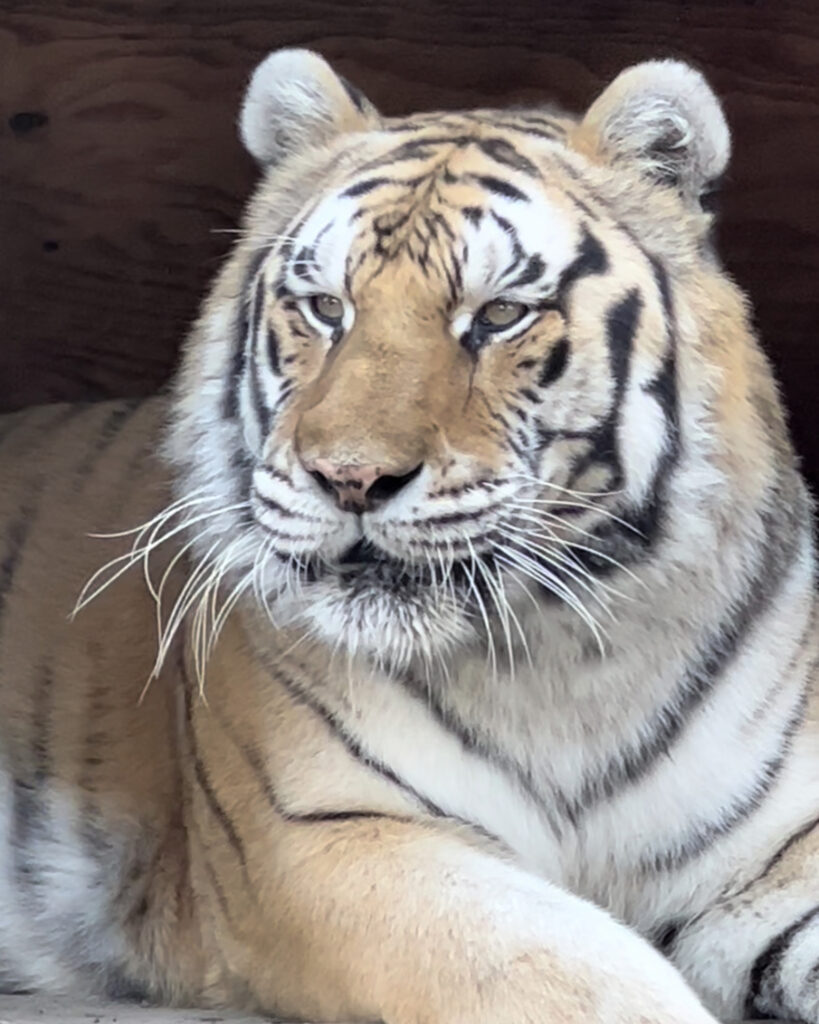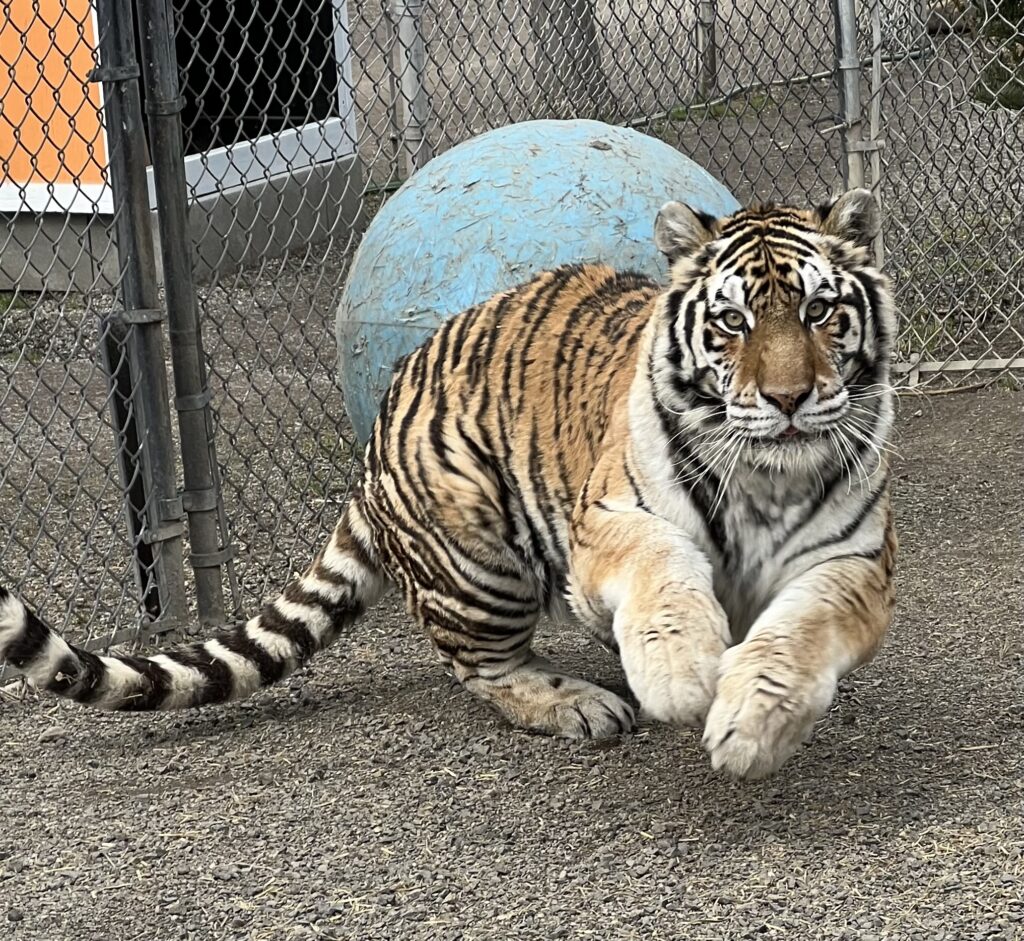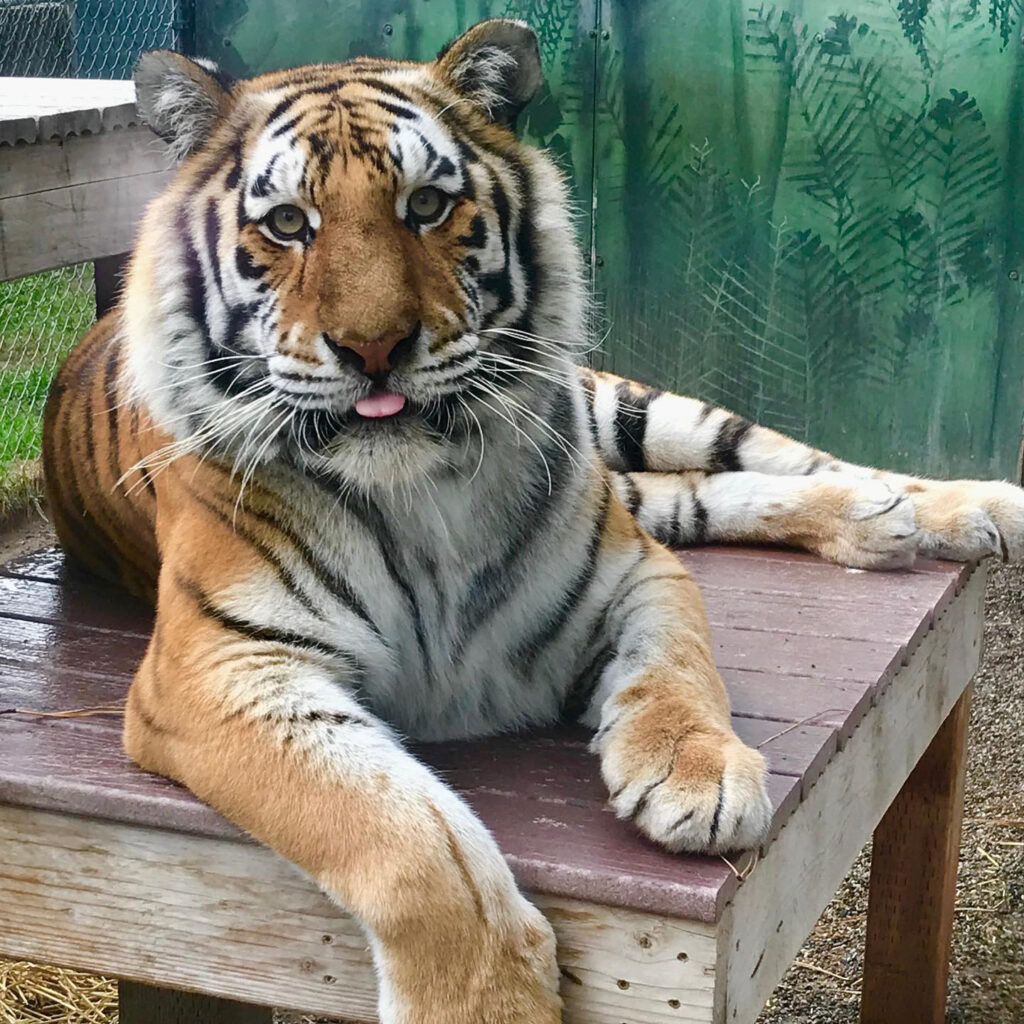Siberian Tigers – Koshka, Sestra & Amura
(Panthera tigris altaica)
Powerful. Resilient. Born for the Cold.
The Siberian, or Amur Tiger, is the largest of all tiger subspecies—built to survive the harsh winters and vast forests of eastern Russia. With dense coats, powerful muscles, and striking pale stripes, these majestic cats embody both strength and endurance.
At Cat Tales Wildlife Center, our Siberian tigers—Koshka, Sestra, and Amura—represent the legacy of a past generation of conservation-focused breeding and the evolution of ethical animal care. While large zoos begin to phase out Siberian tigers due to space limitations and changing conservation priorities, sanctuaries like Cat Tales ensure that these magnificent animals live out their lives in safety, dignity, and comfort.
Meet Our Siberian Tigers

Koshka – The Snow King
Born November 24, 2007, Koshka is one of four siblings (Sestra, Malenky, and Tuga) and the largest tiger at Cat Tales. His name translates from Russian as “cat” or “kitten”—a fitting choice for a 650-pound feline who still enjoys playtime like a housecat.
Koshka’s favorite enrichment includes snowmen in winter and pool time in summer, showcasing the playful side of this powerful predator. He’s also known for participating in Big Cat Encounter feeding experiences, where he demonstrates his strength and intelligence up close—always safely behind protected contact barriers.
Watching Koshka in the snow reveals his true heritage: a tiger perfectly at home in the chill, embodying the wild essence of the Siberian forest.
Sestra – The Sister Spirit
Sestra, whose name means “sister” in Russian, was born on November 24, 2007, alongside her brother Koshka. At about 300 pounds, she’s the smallest of the trio but brimming with personality.
The Siberians were the last tigers born at Cat Tales, marking the end of a chapter in the facility’s conservation breeding program. At that time, Cat Tales Wildlife Academy was focused on teaching students about endangered species reproduction, neonatal care, and health observation.
Sestra’s litter—born to Samson and Delilah—was intended for zoo placement, but unforeseen transfer complications meant the cubs all remained at Cat Tales. Today, Sestra serves as a reminder of the sanctuary’s long-standing dedication to animal welfare and ethical evolution—from breeding and care education to permanent rescue and sanctuary operations.


Amura – The Heart of the Family
Born April 13, 2010, Amura came from a later litter and grew up with a very special companion. As a single cub, she was paired with a Great Pyrenees puppy named Sage for companionship during her early months. The two formed a remarkable cross-species bond, playing and growing together until they naturally outgrew their youthful friendship.
Sage went on to become a Cat Tales security dog, while Amura matured into a confident, calm tiger who still carries that social imprint—a blend of curiosity, patience, and quiet power. She spends her days lounging near her pool or rolling in the grass, embodying the serenity and strength of her species.
All About the Siberian (Amur) Tiger
- Range: Far eastern Russia, with small populations extending into China and North Korea.
- Size: The largest tiger subspecies, males averaging 600–700 lbs; females 250–400 lbs.
- Appearance: Thick, pale-gold fur with faint brown stripes and a prominent winter ruff.
- Diet: Large ungulates such as deer and wild boar, supplemented by small mammals, fish, and carrion.
- Adaptations: Dense fur, large paws for snow travel, and a slower metabolism suited for cold climates.
- Behavior: Solitary and elusive; prefers remote forest regions away from human disturbance.
- Conservation Status: Endangered. Only about 430–500 individuals remain in the wild. Poaching, habitat loss, and disease continue to threaten their fragile recovery.
Tigers and the Pet Trade
Even today, Siberian tigers and Bengal-Siberian hybrids are still bred and sold in the United States under the guise of being “pets” or “photo attractions.” As cubs, they appear cute and manageable—but they grow quickly into apex predators.
Laws such as the Big Cat Public Safety Act now make it illegal to privately own or breed tigers for public interaction in the U.S. These protections came too late for many animals, but they ensure that future generations will not endure the same cycle of exploitation.
Conservation & The Future of Tigers
Siberian tigers are among the most endangered big cats in the world. Once reduced to just a few dozen individuals in the 1930s, their population rebounded through conservation—but recent declines remind us that protection is never guaranteed.
Threats include poaching, habitat fragmentation, and disease transmission from domestic animals. Their survival depends on the preservation of large, connected forest habitats and continued international cooperation.
At Cat Tales, Koshka, Sestra, and Amura help educate visitors about tiger ecology, conservation challenges, and the responsibility we share to ensure these magnificent animals endure.
Life at Cat Tales
Our Siberian tigers live in expansive habitats that mimic their natural environments with shaded dens, logs, and pools.
- Enrichment: Seasonal snow piles, frozen treats, and large barrels stimulate play and exercise.
- Climate Adaptation: Their thick coats make Spokane’s winters an ideal environment.
- Behavioral Care: Keepers monitor interactions, appetite, and activity to ensure each tiger remains healthy and engaged.
Their routines remind us that big cats, even in sanctuary care, retain every instinct of their wild heritage.
How the Siberian Tigers Inspire
Education
Their stories connect visitors to global tiger conservation and teach about responsible wildlife stewardship.
Advocacy
By sharing their journeys, we help the public understand why wild animals belong in the wild—and why sanctuaries are vital.
Research & Welfare
Daily observation and enrichment help improve captive care standards for large carnivores worldwide.


